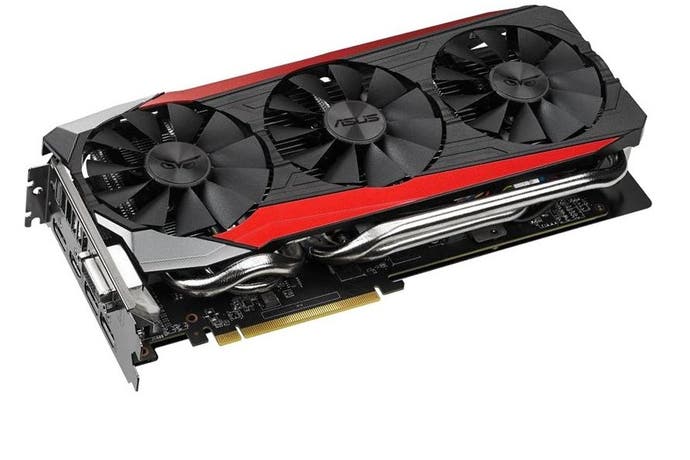AMD's cut-down, air-cooled R9 Fury is a 4K contender
Digital Foundry has initial benchmarks for the new challenger.
AMD has lifted the lid on the cheaper, cut-down, air-cooled version of its top-end R9 Fury X - and we've had a day of hands-on time with the new product. Our initial thoughts? Some of the cutbacks may look significant and the small form-factor of the top-tier product is gone, but the new non-X Fury offers an accomplished level of performance at ultra-HD resolution. On top of that, initial overclocking results paint an interesting picture of Fury performance when compared to the full-fat product.
As far as we're aware, only two different Fury boards are available at launch, with key AMD partners Sapphire and Asus offering up designs based on their top-end tri-fan coolers. Our test board comes from the latter, using its new DirectCU 3 technology - and it's a beautiful piece of kit, more than up to the task of cooling the large Fiji processor. We noted max temperatures in the mid-70s Celsius, even when overclocked - though this was on an open air test bed.
In terms of the Fury itself, the inevitable comparisons with the top-end X model reveal a drop from 4096 to 3584 shaders (a loss of 12.5 per cent in shading resources) while texture units drop from 256 to 224. Base clock speeds drop from 1050MHz to 1000MHz. Otherwise, the spec remains static - the all-important next-gen HBM memory remains in effect at the full 4GB, still running at 500MHz.
But the most important cutback is in the price - the air-cooled Fury is $100 cheaper than the top-tier water-cooled card, so assuming the compromises made to the design aren't too severe, the R9 Fury could be something else too - the cheapest viable 4K gaming card on the market. The success of the product is all going to hinge on its performance, so here's an initial look at how the card operates at 4K, where - based on Fury X results, at least - we should see the air-cooled model perform at its best.
| 3840x2160 (4K) | R9 390X | GTX 980 | Titan X | GTX 980 Ti | R9 Fury X | R9 Fury | R9 Fury (OC) |
|---|---|---|---|---|---|---|---|
| The Witcher 3, High, HairWorks Off, Custom AA | 29.1 | 27.7 | 37.5 | 36.9 | 36.2 | 33.1 | 35.5 |
| Battlefield 4, High, Post-AA | 44.5 | 46.8 | 61.3 | 61.0 | 51.0 | 47.7 | 51.0 |
| Crysis 3, High, SMAA | 40.2 | 39.0 | 52.4 | 52.5 | 49.2 | 45.6 | 48.9 |
| Assassin's Creed Unity, Very High, FXAA | 22.7 | 21.8 | 27.4 | 26.5 | 25.3 | 23.0 | 25.0 |
| Far Cry 4, Very High, SMAA | 44.4 | 36.1 | 46.7 | 47.1 | 50.5 | 47.3 | 50.9 |
| Ryse: Son of Rome, Normal, SMAA | 37.8 | 31.5 | 42.2 | 41.7 | 44.0 | 40.9 | 43.6 |
| Shadow of Mordor, High, High Textures, FXAA | 50.1 | 42.4 | 54.8 | 54.8 | 55.5 | 51.6 | 55.4 |
| Tomb Raider, Ultra, FXAA | 51.4 | 47.1 | 64.6 | 61.3 | 63.9 | 55.5 | 60.0 |
There are some good results here - at stock, the Fury is only 8.3 per cent slower than the X on aggregate, and 9.5 per cent slower than the GTX 980 Ti. On average, the Fury is around 18 per cent faster at 4K than the GTX 980, though AMD optimised games like Shadow of Mordor, Ryse and Far Cry 4 are anything from 20 to 30 per cent faster. The good news continues in that overclocking brings the Fury within striking distance of the Fury X on all but one game - Tomb Raider. Indeed, factoring out the 2013 Lara Croft adventure shows that the overclocked Fury is 99 per cent as effective as the Fury X.
And that's with what we would consider a relatively unimpressive overclock. We could only add 65MHz to the core clock, but we could overclock the HBM memory. AMD doesn't provide this functionality out of the box, but MSI Afterburner features the ability to disable the restriction, and we were to overclock the memory by an additional 50MHz before anomalies started to appear. In practise, this only adds a tiny amount of performance (it's literally 1fps in Crysis 3 at 1440p), but it's free, and doesn't appear to impact thermals too much - and in an architecture where overclocking headroom is limited, we'll take any boost we can get.
It's still early days with the Fury, but at 4K at least, we are seeing AMD carve out its own niche - it's faster than MSI's factory overclocked R9 390X (though only by around eight per cent on aggregate) and swifter than GTX 980, while managing to compare favourably with Fury X and indeed GTX 980 Ti (at reference clocks, at least). Just like the Fury X, it's a creditable contender for those operating 4K displays, but it's worth sounding a note of caution about performance at lower resolutions, where the top-tier AMD product clearly struggled.
Testing continues right now, but what we can say is that just like the Fury X, the new card still has problems competing at sub-4K pixel counts. The air-cooled Fury is slower than the Fury X at both 1080p and 1440p, where the GTX 980 is impressive in terms of both stock and overclocked performance - that's going to be a really interesting comparison. Also worthy of note is pricing: we're still waiting to hear about UK costs for the air-cooled Fury, which is especially pertinent bearing in mind that certain GTX 980 models are now available in the region of £360-£370.


